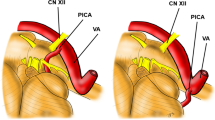Abstract
Background
Posterior communicating artery aneurysms sometimes present with partial or complete oculomotor nerve palsy, due to direct oculomotor nerve compression, irritation by subarachnoid blood, or both. Superiority of surgical clipping over endovascular coiling in terms of postoperative outcome is still controversial.
Method
Direct oculomotor nerve decompression by opening of the anterior petroclinoid ligament during aneurysm clipping is performed as a simple and feasible surgical maneuver which allows to improve the decompression effect obtained by aneurysm exclusion.
Conclusion
Anterior petroclinoid ligament opening permits to achieve a better oculomotor nerve decompression. Its efficiency on the recovery of the deficit needs to be proved by larger series.
Similar content being viewed by others
Abbreviations
- ONP:
-
Oculomotor nerve palsy
- PCoA:
-
Posterior communicating artery
References
Brigui M, Chauvet D, Clarencon F, Degos V, Sourour NA, Nouet A, Clemenceau S, Boch AL, Bernat AL, Di Maria F, Cornu P (2014) Recovery from oculomotor nerve palsy due to posterior communicating artery aneurysms: results after clipping versus coiling in a single-center series. Acta Neurochir 156:879–884
Chalouhi N, Theofanis T, Jabbour P, Dumont AS, Gonzalez LF, Starke RM, Gordon D, Rosenwasser R, Tjoumakaris S (2013) Endovascular treatment of posterior communicating artery aneurysms with oculomotor nerve palsy: clinical outcomes and predictors of nerve recovery. AJNR Am J Neuroradiol 34:828–832
Chen PR, Amin-Hanjani S, Albuquerque FC, McDougall C, Zabramski JM, Spetzler RF (2006) Outcome of oculomotor nerve palsy from posterior communicating artery aneurysms: comparison of clipping and coiling. Neurosurgery 58:1040–1046 discussion 1040-1046
Gaberel T, Borha A, di Palma C, Emery E (2016) Clipping versus coiling in the management of posterior communicating artery aneurysms with third nerve palsy: a systematic review and meta-analysis. World Neurosurg 87:498–506 e494
Gonzalez-Darder JM, Quilis-Quesada V, Talamantes-Escriba F, Botella-Macia L, Verdu-Lopez F (2012) Microsurgical relations between internal carotid artery-posterior communicating artery (ICA-PComA) segment aneurysms and skull base: an Anatomoclinical study. J Neurol Surg B Skull Base 73:337–341
McCracken DJ, Lovasik BP, McCracken CE, Caplan JM, Turan N, Nogueira RG, Cawley CM, Dion JE, Tamargo RJ, Barrow DL, Pradilla G (2015) Resolution of oculomotor nerve palsy secondary to posterior communicating artery aneurysms: comparison of clipping and coiling. Neurosurgery 77:931–939 discussion 939
Nossek E, Setton A, Dehdashti AR, Chalif DJ (2014) Anterior petroclinoid fold fenestration: an adjunct to clipping of postero-laterally projecting posterior communicating aneurysms. Neurosurg Rev 37:637–641
Panagiotopoulos V, Ladd SC, Gizewski E, Asgari S, Sandalcioglu EI, Forsting M, Wanke I (2011) Recovery of ophthalmoplegia after endovascular treatment of intracranial aneurysms. AJNR Am J Neuroradiol 32:276–282
Sheehan MJ, Dunne R, Thornton J, Brennan P, Looby S, O'Hare A (2015) Endovascular repair of posterior communicating artery aneurysms, associated with oculomotor nerve palsy: a review of nerve recovery. Interv Neuroradiol 21:312–316
Tan H, Huang G, Zhang T, Liu J, Li Z, Wang Z (2015) A retrospective comparison of the influence of surgical clipping and endovascular embolization on recovery of oculomotor nerve palsy in patients with posterior communicating artery aneurysms. Neurosurgery 76:687–694 discussion 694
Author information
Authors and Affiliations
Corresponding author
Additional information
Key points
• A frequent presentation of PCoA aneurysms is ONP, which can be partial or complete
• ONP is probably caused by direct compression of the aneurysm, its pulsations and/or the irritation of subarachnoid blood
• Surgical clipping may be superior in terms of ONP recovery because indirectly decompresses the nerve after aneurysm exclusion, but there is still debate on it
• A large amount of studies conclude that the two treatment options are almost the same
• Anterior petroclinoid ligament is a dural fold which sometimes creates an additional compression on the oculomotor nerve
• During surgery, after the placement of the clip, a small opening can be made in this tentorial extension to directly decompress the nerve
• This maneuver has previously described only for surgical purposes, in order to better visualize aneurysm neck
• The technique for direct decompression is quite feasible and could be performed during standard surgery without any specific or complex instrumentation
• The direct nerve decompression, when it can be performed, creates an additional beneficial effect on the nerve
• This results in shorter recovery time and better functional outcome
This article is part of the Topical Collection on Neurosurgical Anatomy
Electronic supplementary material
The video shows the key phases of the surgical procedure. In the first phase, a sharp arachnoid dissection is performed to carefully expose the aneurysm neck. After that, the clip is placed and the aneurysm is excluded from circulation, with verification by ultrasound probe. In the end, a 4–5 mm long opening in the anterior petroclinoid ligament is performed to decompress the third cranial nerve to improve the postoperative visual outcome. ICA, internal carotid artery; ON, optic nerve; Third CN, third cranial nerve. Note: The patients gave us the consent to publish the video in an anonymous way.(MP4 243198 kb)
Rights and permissions
About this article
Cite this article
Bertulli, L., Reinert, M. & Robert, T. Third nerve decompression by anterior petroclinoid ligament opening after clipping of posterior communicating artery aneurysm—How I do it. Acta Neurochir 160, 2187–2189 (2018). https://doi.org/10.1007/s00701-018-3666-x
Received:
Accepted:
Published:
Issue Date:
DOI: https://doi.org/10.1007/s00701-018-3666-x




